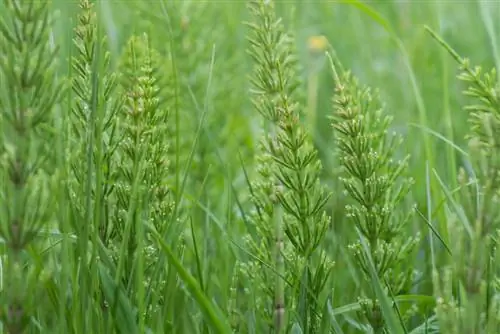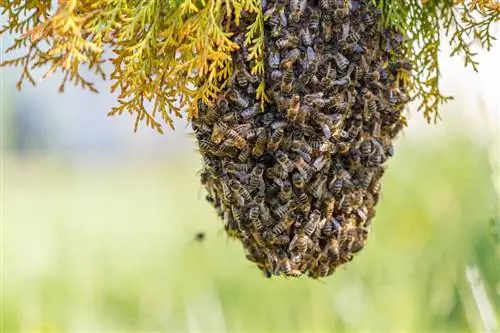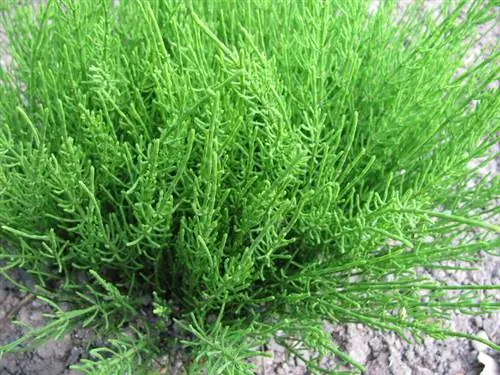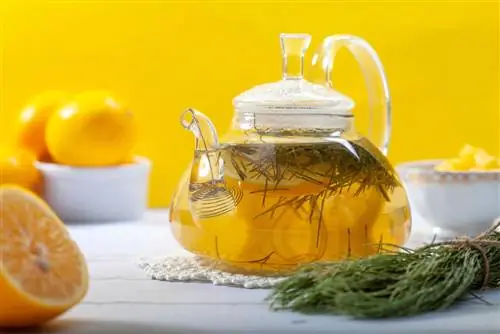- Author admin [email protected].
- Public 2023-12-26 14:17.
- Last modified 2025-06-01 06:02.
This plant drives gardeners crazy when its rootstock spreads over large areas within a short period of time. It indicates that the floor is not good and needs more attention. Field horsetail enriches the menu and serves as a medicinal plant.
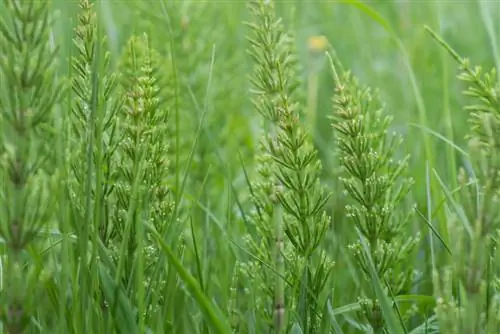
What to do about field horsetail?
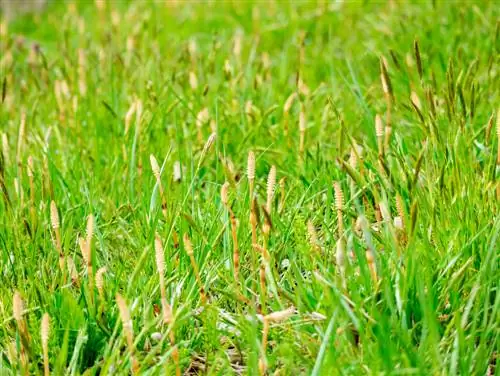
Field horsetail has deep roots and is therefore difficult to control
If you have field horsetail (Equisetum arvense) in your garden, you won't get rid of it so quickly. The plant develops a large rootstock that extends up to 160 centimeters into the ground and new shoots continually grow from it. If you want to combat field horsetail, a lot of patience is required. However, you should avoid using Roundup. The success of chemical control of field horsetail is short-lived and not only harms nature but also its he alth.
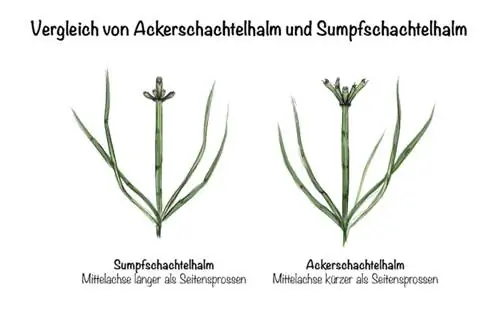
Field horsetail as an indicator plant for:
- Soil compaction
- damaging wetness
- Moisture in clay or subsoils
Soil improvement
Field horsetail is an important indicator of waterlogging because it feels particularly comfortable in heavily compacted and waterlogged clay soils. In order to deprive the so-called horsetail of the living conditions, you should thoroughly loosen up and dig up existing gardens and new building plots.
Destroy field horsetail in the lawn:
- Mow the lawn in spring so that less than five centimeters remain
- Test soil pH
- If necessary, increase to 7.0 to 8.0 by liming
Remove all root parts from the substrate. If the vegetation is less severe, green manure with lupins is recommended. These plants develop an extensive root system that loosens the soil down to deeper layers. The emerging horsetail should be chopped off regularly. Within a season, the spore plants show signs of weakness until they finally disappear.
Do sprays help against field horsetail?
Many remedies for field horsetail that are available commercially only destroy the weeds for a short time and above ground. The rootstock growing in the substrate is not negatively affected by the active ingredients. Therefore, the shoots often sprout again shortly after treatment. Since chemical agents can harm both the environment and he alth, you should avoid these control measures.
Using field horsetail in the garden
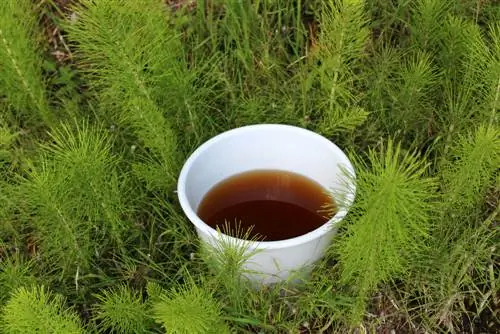
Field horsetail manure is a great home remedy against pests and diseases
Because of its valuable ingredients, horsetail is considered a natural and environmentally friendly means of combating plant pests and fungi. Regular use strengthens ornamental and crop plants so that they are less susceptible to pests.
This is how horsetail works:
- generally serves to strengthen plants
- Silicic acid dries out germinating fungal hyphae
- growth-regulating effect by strengthening plant cells
- helps against mildew, spider mites, rust, scab and curl disease
Excursus
Why the field horsetail is also called horsetail
In the past, field horsetail was used as a household cleaning agent. People made use of the silica of the spore plant, which makes up almost ten percent of all ingredients. An aqueous decoction was used to clean objects containing tin, which could be gently removed from dirt using the silica crystals of the herb

Field horsetail against powdery mildew
To prevent infestation by mildew fungi, we recommend watering the plants regularly with horsetail manure. If your ornamental and crop plants are acutely affected, you can spray the decoction directly onto flowers, leaves and stems every two days.
How to make horsetail decoction:
- Pour 500 grams of fresh shoots with five liters of water
- let it steep for a day
- Boil the broth for 30 minutes and strain
- dilute before use (one part stock and five parts rainwater)
The advantage of horsetail is its environmentally friendly effect. Since field horsetail concentrate is harmless, it can also be used on vegetables such as cucumbers, tomatoes or zucchini as well as roses, which are considered susceptible to fungi.
Make fertilizer
With manure made from field horsetail, valuable ingredients are dissolved in the water through fermentation, which occurs automatically after one or two days. If you want to make manure, a large plastic container with a capacity of ten liters is recommended.
Collect about a kilogram of horsetail and pour lukewarm water over the chopped plant parts in a bucket. Place the container in a warm place so that fermentation starts quickly. After 14 days the process is almost complete, which you can see by the reduction in the formation of bubbles.
Tips for use:
- The smell can be reduced by adding rock dust
- Dilute the broth with water (1:50) before spraying
- For watering, a dilution of 1:20 is sufficient
Use as a medicinal plant - recipes
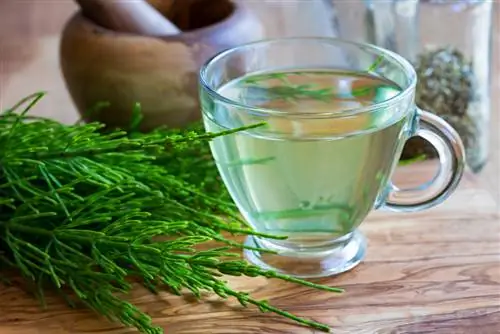
horsetail tea had an anti-inflammatory effect
There is consolation for those who, despite all attempts to combat it, cannot completely banish horsetail. It can be used in many ways in the home, for cosmetic purposes and in medicine. Field horsetail extract is characterized by valuable ingredients that have positive he alth properties. In naturopathy there are various ways to use these benefits of the plant:
| Definition | Substances for dissolving the ingredients | Ratio of plant material to liquid substance | |
|---|---|---|---|
| Extract | liquid or viscous extract from plant material | Alcohol, oil, wine, vinegar | only possible up to 1:1 if you make it yourself |
| Tincture | liquid extract from plant material | Alcohol as a solvent | 1:5 or 1:10 |
| Concentrate | Powder or liquid with concentrated active ingredients | Filler only in case of liquid essences | Fluid (1:1 to 2:1), thick (up to 3:1), dry concentrate (from 4:1) |
| Oil macerate | oily extraction by cold or hot method | Rapeseed, sunflower or coconut oil | usually 1:3 |
| Tea | watery herbal infusion | Water | varies depending on your preference and taste |
Prepare tincture
Alcoholic extracts are easy to produce. With this method, the valuable ingredients are extracted from the plant parts and preserved at the same time, so that a tincture lasts up to 24 months. Commercially available alcohol with 50 percent or 70 percent ethanol is suitable for this.
Procedure:
- Cut horsetail herb into small pieces and fill into a screw-top jar
- Fill the container with high-percentage solvent until all parts of the plant are covered
- place the closed jar in a temperate and dark place
- Shake daily to help dissolve the active ingredients
- strain and bottle after three to four weeks
Recipe for oil extracts
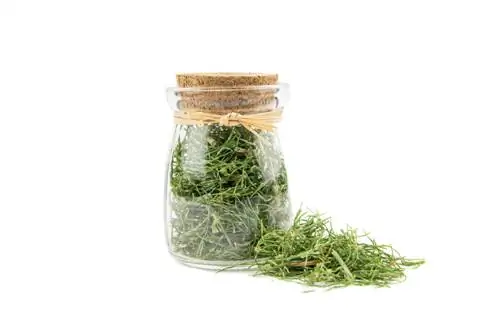
To obtain an oil extract, you only need to pour oil over the dried plant parts
Collect the fresh green horsetail shoots in spring and chop them up with a sharp knife after washing. Place the plant material in a screw gas so that it can be doused with about 80 ml of vegetable oil. Oils from rapeseed, sunflower, coconut, olive or sesame seeds are ideal.
It is important that the chopped plant parts are completely covered with oil. The closed jar is placed in a dark place for three to four weeks until the oil extract has matured. Shake the jar regularly to prevent mold from forming. The horsetail oil is then filtered and filled into dark colored bottles.
Make horsetail ointment
To make an ointment you need an oil extract and a few drops of horsetail tincture. Put the oil in a larger jar along with about ten grams of beeswax. Place this in a water bath and let the mixture melt on the stove over low heat. Then stir in 20 grams of cocoa butter.
How to proceed:
- Take the glass out of the water bath and let it cool down a little
- Add about 30 drops of tincture and stir well
- if the consistency is too runny, add more beeswax
- Ointments that are too solid can be liquefied with oil
If the mixture is neither too solid nor too liquid, you can pour the finished ointment into a dark container and let it cool, stirring occasionally. For a longer shelf life, the horsetail cream should be stored away from light and in a cool place. Because of the high fat content, the homemade lotion is slowly absorbed into the skin. It is ideal for a massage after a shower.
Excursus
Field horsetail in medicinal preparations
Silicic acid is an oxidized and naturally occurring form of silicon, also known as silicon dioxide. The chemical element is considered an important building block for nails, hair and connective tissue. This substance ensures that the spore plant can grow upright. The strengthening effect of silica has been scientifically proven, as has its positive effects on the urinary tract. Horsetail concentrates are therefore often used in natural medicine or, for example, in the form of tablets as nutritional supplements.
Field horsetail tea
Dried or fresh horsetail in tea blends is used to promote your he alth. Organic teas are available in he alth food stores or pharmacies. The material collected from the garden is also ideal. Drink a cup of freshly made tea two to four times a day between meals.
Tea preparation:
- Pour 150 ml of boiling water over one to two teaspoons of dried herb
- Simmer the infusion for about 20 minutes so that the silica dissolves in the tea
- Pour the liquid through a sieve
Tip
The tea can also be used as a gargle solution for gum problems or tonsillitis.
What you need to know about collecting and processing
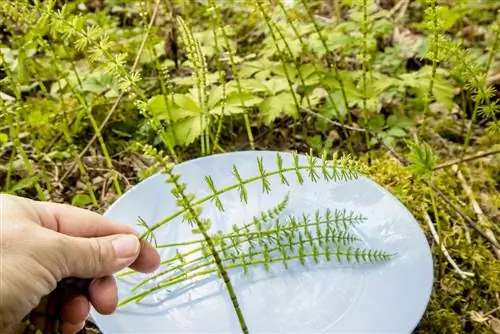
Field horsetail looks very similar to the poisonous horsetail
Before you go out into nature and collect field horsetail, you should look at species that look similar. There is a risk of confusion with plants that are poisonous. The toxicity mainly relates to grazing livestock. There are no known cases of poisoning caused by marsh horsetail in humans. However, as a precaution, you should not consume the similar-looking horsetail in tea mixtures.
Field horsetail in profile
The fern plant develops sterile shoots that are between ten and 50 centimeters high. The entire plant is traversed by ventilation channels, which can be seen in a cross section through the stem. It is noticeable that the central tube takes up about a quarter of the total diameter. This fact is an important identifying feature of the field horsetail.
Field horsetail grows here:
- often on damp meadow edges
- also in ditches and embankments with clayey soil
- increasingly rare in fields
The stem has between six and 20 ribs. It reaches a diameter of three to five millimeters. The roots develop laterally extending shoots, which mature into tuberous storage organs. These contain a lot of starch and can be used as root vegetables in the kitchen.
The marsh horsetail likes to grow in the immediate vicinity of the field horsetail. Occasionally the two species socialize with each other.
Swamp horsetail: difference from field horsetail
With a little practice and an eye for detail, you can safely recognize the field horsetail and avoid confusion. Horsetails consist of many individual limbs, the ends of which appear to be interlocked. These sheaths can be recognized on the stem and side branches. The teeth at the top are noticeable.
| Swamp Horsetail | Field horsetail | |
|---|---|---|
| Bloom | Spore stands sit at the end of the green shoots | brownish spore shoots appear before the green sterile shoots |
| Seeds | Spore ripening from June to September | Spore ripening from March to May |
| Teeth of the stem sheaths | 6 to 10 | 10 to 12 |
| Shape of the side branches | star-shaped (five to hexagonal) | square |
| most striking distinguishing feature | Stem sheaths longer than the first branch (“broom” visible when torn off) | Stem sheaths shorter than first branch part |

Instructions for drying
If you want to dry field horsetail, you should collect the fresh sterile shoots in spring. The best harvest time is between May and July, as the young shoots have many times more valuable ingredients than older herbs.
Tip
Make sure that there are no dark brown spots on the branches. These indicate a fungal infection that sprouts in late summer and weakens the plant.
Cut off only the top two-thirds of the plant and tie the stems together with string. The bundles are hung in an airy place where they dry over the next few weeks. You can then store the dried bouquets in a linen bag or chop them up and make tea.
Field horsetail and its healing effects
In addition to its positive effect in the garden as a plant protection product, field horsetail has proven to be a he alth-promoting plant in natural medicine. The herb has been valued as a medicinal plant for centuries. To this day, the plant parts are used as a single drug in tablets, tinctures and powdered concentrates or as an admixture to tea. Its effect on the urinary tract has been proven.
Versatile uses:
- Inflammation: Tea for flushing out bacterial diseases of the urinary tract and kidneys
- Chronic diseases: Infusion helps with chronic coughs or osteoarthritis
- Strengthening: supports metabolism and blood circulation
- Cosmetics: in ointments to reduce stretch marks and cellulite
- Animal treatment: against respiratory diseases in horses
- Care: as a shampoo or conditioner for dull and flaky hair
Ingredients
The green summer shoots, which do not reproduce generatively, are used to combat he alth problems. The plant parts contain around ten percent mineral components such as silica, the content of which varies between five and eight percent. This means that the species has the highest proportion of silicon dioxide of all plants, ten percent of which is in water-soluble form.
Other components:
- Flavonoids: kaempferol and querectin
- caffeic acid: tartaric and shikimic acid
- Alkaloids: Nicotine and palustrine in traces
Side effects and caution
There are no known undesirable side effects from taking field horsetail. However, people with water retention in the tissue caused by heart or kidney failure should avoid internal use. Since horsetail has a strong diuretic effect, consuming teas and tinctures can have negative consequences.
What else you should know
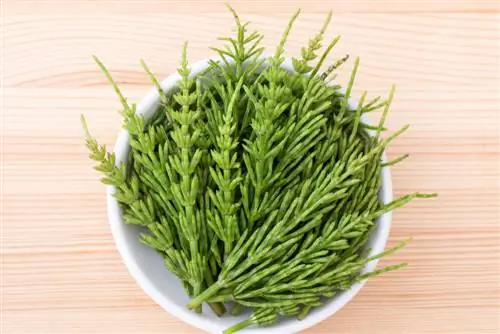
Field horsetail is also available to buy - but rarely fresh
There are different ways to get the he alth-promoting field horsetail herb. If you neither want to observe the plant in the garden nor collect it in nature, you can switch to finished products or fresh plants. For initial attempts at application, it is recommended to use high-quality tea herbs from organic cultivation.
Buy field horsetail
An alternative to collecting is to buy dried herbs. Organic quality teas and extracts are available in pharmacies or drugstores such as dm. Before you decide on a product, you should take a closer look at the manufacturer. Important decision criteria are not only price but also origin and quality.
Buy tablets and tea - note prices:
- Horsetail herb tea from online pharmacies: between two and four euros per 100 grams
- Vita Nova organic field horsetail tea from the he alth food store: 100 grams for 5.52 euros
- ultraPROTECT field horsetail capsules from Dr. File: 100 grams for 39.80 euros
Can you make concentrate yourself?
A concentrate is a product in which the liquid disappears in part or almost completely by evaporation. In industrial production, this process takes place under vacuum and at low temperatures so that the valuable ingredients are not lost. What remains is a powder that is processed into tablets or capsules. Using common methods in the kitchen, you can make a maximum of extracts with a ratio of 1:1. Drying processes in the oven are not gentle enough, so the valuable active ingredients are lost.
UltraPROTECT concentrate - experiences:
- liquid concentrate is sufficient for several weeks due to its high yield
- no clear reports regarding the effect
- Product contains additives such as potassium sorbate
- causes side effects such as nausea
- expensive compared to high-quality alternatives from he alth food stores and pharmacies
Growing field horsetail in a pot
If you want to process horsetail into powder but don't have the opportunity to collect it, you can buy a plant and cultivate it in a bucket. Since the herb reproduces independently in the planter, regular harvesting is possible without any problems. Make sure that the fern plant is sufficiently moist and partially shaded.
Frequently asked questions
Is field horsetail poisonous?
The fern plant known as horsetail is not poisonous, but contains he alth-promoting ingredients. Both the fertile shoots that sprout in spring and the sterile shoots that grow later are used in the kitchen. Inexperienced people can quickly confuse this species with the swamp horsetail. This plant is considered poisonous to grazing livestock and should not be consumed by humans, although no cases of poisoning have been observed so far.
How can I grow field horsetail in the garden?
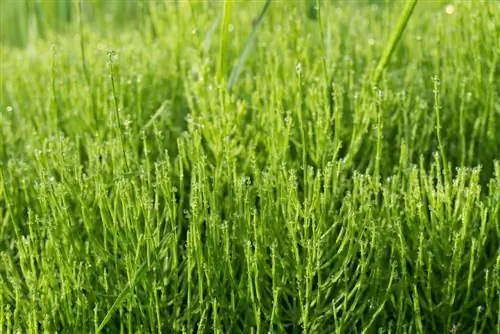
If you want to grow field horsetail, you should contain it well
If you want to plant field horsetail, you should either choose a secluded place in the garden or switch to cultivating it in a container. The plant reproduces rapidly through underground runners and can quickly take over large areas. Root barriers or planters allow controlled cultivation. Horsetail produces high yields even without regular care. Compacted soils with nutrient-poor conditions are important. The plant grows in sunny to shady areas and is not affected by waterlogging.
What helps against field horsetail?
So far no herb has grown that will completely eradicate field horsetail. However, lupins can help because they develop a deep root system and loosen the soil thoroughly. To worsen the living conditions for the weeds, you should eliminate soil compaction. Digging up is not only useful if there is existing field horsetail growth, but is also recommended as a preventive measure on undeveloped land.
Can you eat the brown shoots of field horsetail?
The flowering period of the field horsetail extends from March to May, although the plant, as a fern in the botanical sense, does not bloom, but allows spores to ripen. These spore-forming plant parts appear in spring at the tips of brownish shoots that have no branches. They can be collected and processed into stir-fried vegetables because of their mushroom aroma or used as a filling. The shoots can be preserved by s alting.
What are the options for making field horsetail extract?
Since plant extracts in liquid form react sensitively to moisture, light and heat, dry extracts have proven themselves as a dosage form in medicine. In your own household, it is difficult to remove the liquid from solutions by gentle evaporation.
Therefore, fluid extracts or tinctures are the better alternative for home production. The water- and fat-loving plant substances dissolve best when extracted with 70 percent alcohol. A mixing ratio of five parts ethanol and one part fresh plant material is ideal. This is poured over with the solvent so that the active ingredients can dissolve.

